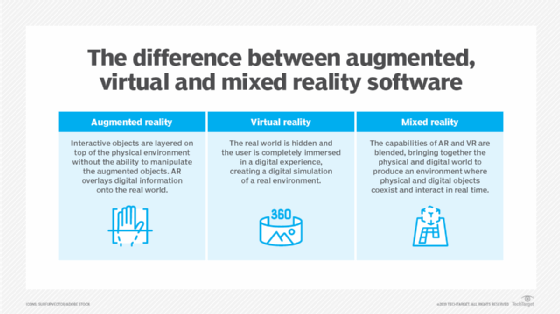room-scale virtual reality (VR)
What is room scale virtual reality (VR)
Room-scale (or roomscale) virtual reality (VR) is the use of clear space to allow movement for someone using a VR application such as a VR game. When the user can physically move within the space, it becomes possible to replicate real-world actions in the virtual world and thus make the virtual environment seem more real.
The term room-scale distinguishes this kind of virtual reality setup from seated or standing VR setups in which the user remains stationary as they engage with the virtual environment.
Key features of room-scale VR
Room-scale VR is about matching the functionality of a VR program to a specific physical space in order to provide more compelling and realistic VR experiences to users. Users can walk through a real physical space and their movements will be translated into the virtual world. They have full control of their virtual world, from interacting with objects to moving across the environment.
All is achieved by tracking full-body movement and immersing users to explore the environment naturally and at will. These capabilities help create more realistic "total body" VR experiences in room-scale VR environments, which is not possible with passive VR demos or 360 video.
Room-scale VR uses a combination of movement and VR headset tracking within a dedicated area to simulate moving in the virtual environment. Because users can move naturally and freely interact with virtual objects in the VR environment, room-scale VR helps create more interactive, immersive and interesting VR experiences.
To deal with space limitations, a chaperoned movement system guides users away from the real room's walls. It also shortens straight-line movements within the environment. Users can also employ strategies such as teleportation to avoid hitting boundaries that may disturb their immersion in the VR application.

Setting up room-scale VR
Room scaling boosts the sophistication and immersion of VR platforms and applications. To achieve those objectives, certain resources are required, including software to match a physical space to a virtual world and tactile equipment to regulate a user's motion through the room-scaled space.
To achieve a realistic and comfortable VR experience, the right amount of space is essential. Ideally, the size of the room should be at least 6.5ft x 5ft (2m x 1.5m). A virtual space is then "mapped" into this physical space to make the virtual world fit into the real world. Often, room scaling involves light sealing and optimizing the acoustics of the physical space.
In addition, room-scale VR includes internal and external sensors to simulate realistic virtual environments. Internal sensors and prebuilt cameras in VR headsets like Oculus Rift track a user's position and surrounding area. They then adjust the virtual world to provide immersive VR experiences for gaming and other applications. External sensors are set up around the VR room to track users and their actions.
Applications of room-scale VR
Two of the most popular applications of room-scale VR are for gaming and for enterprise use cases.
Gaming. With the gaming industry evolving at a rapid pace, room-scale VR provides great opportunities for developers to create more exciting and immersive games. They can craft new stories and design exotic environments so users feel as if they are living the game, not just playing it.
Because users can move around the physical environment (room), they can see and experience new perspectives, which makes the entire gaming presence more engaging than a normal seated VR experience.
Enterprise. Companies can use room-scale VR to create realistic scenarios that support employees' day-to-day work, whether it involves testing, design, training or other work-related activities. Room-scale VR is useful for simulating real-world environments to understand how users might react to a certain situation and if the reaction is appropriate and desirable.
Room-scale VR can also help analyze what's working and what's not, particularly in situations that involve the use of physical tools. Users can test and manipulate virtual tools to understand how they work. Supervisors can see how users react and make decisions under various scenarios to correct shortcomings and ensure that the real tools are used correctly, safely and productively.
Room-scale VR can also be used to conduct consumer research to understand behaviors and preferences, and to test new products with consumer groups.
Room-scale VR vs. seated 360-degree VR
In room-scale VR, users can physically walk within a specified physical area and make real-world motions while experiencing the virtual environment. In seated 360-degree VR, users are surrounded by animations, videos, games or slides on all sides. However, the user remains seated during the virtual reality experience. Because users don't physically interact with the environment to the same extent as room-scale VR, seated 360-degree VR is less immersive than room-scale VR.
Despite offering a less immersive experience, 360-degree VR has some advantages over room-scale VR. It's more expensive to set up a room-scale VR environment because it requires a large open space for users to walk around in. The costs of motion tracking and headset equipment can also be steep. Other necessary -- and expensive -- equipment includes:
- a three-prong power supply;
- a high-performance computer and monitor; and
- in outside areas, some type of shelter to protect the sensors and other equipment from the sun, wind and rain.
A 360-degree VR environment does not require specialized tools or equipment except for a VR headset to experience the environment. Also, because 360-degree VR takes place in a seated position, a large room is not required.
See also: virtual reality gaming, immersive virtual reality, enterprise uses for virtual reality
